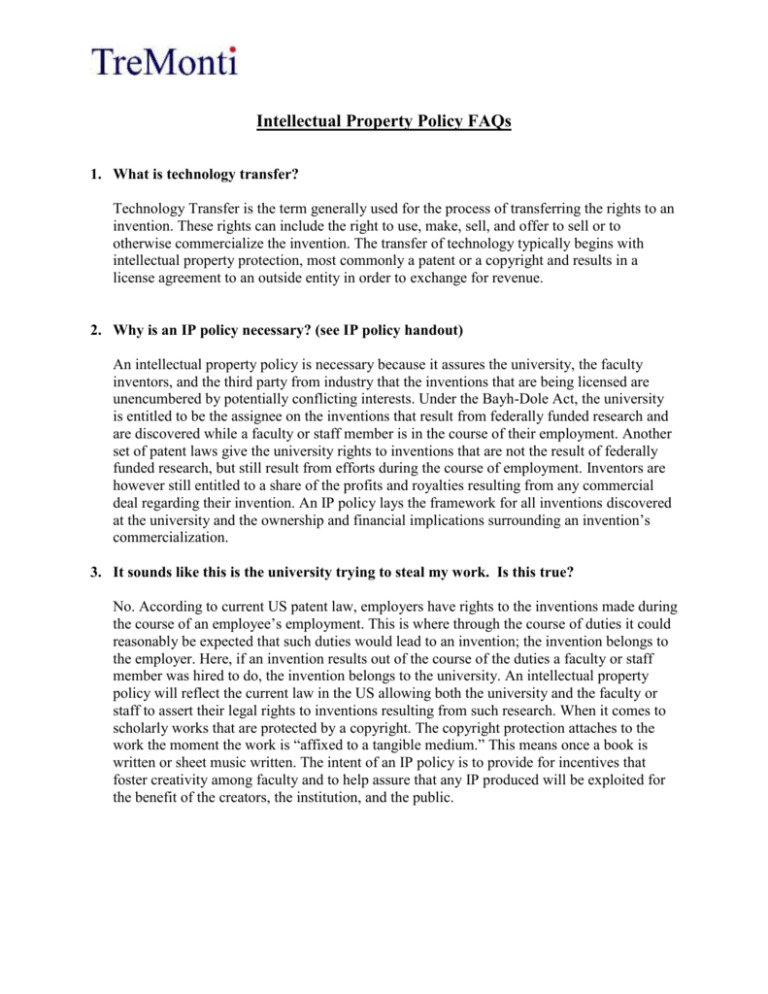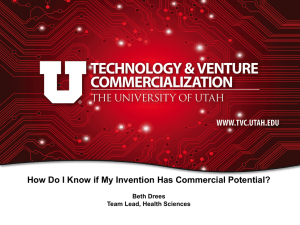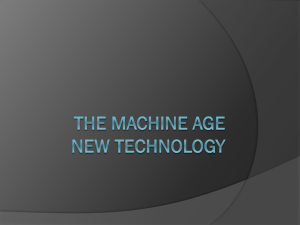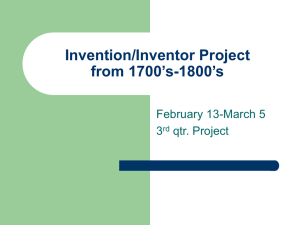Intellectual Property Policy FAQs
advertisement

Intellectual Property Policy FAQs 1. What is technology transfer? Technology Transfer is the term generally used for the process of transferring the rights to an invention. These rights can include the right to use, make, sell, and offer to sell or to otherwise commercialize the invention. The transfer of technology typically begins with intellectual property protection, most commonly a patent or a copyright and results in a license agreement to an outside entity in order to exchange for revenue. 2. Why is an IP policy necessary? (see IP policy handout) An intellectual property policy is necessary because it assures the university, the faculty inventors, and the third party from industry that the inventions that are being licensed are unencumbered by potentially conflicting interests. Under the Bayh-Dole Act, the university is entitled to be the assignee on the inventions that result from federally funded research and are discovered while a faculty or staff member is in the course of their employment. Another set of patent laws give the university rights to inventions that are not the result of federally funded research, but still result from efforts during the course of employment. Inventors are however still entitled to a share of the profits and royalties resulting from any commercial deal regarding their invention. An IP policy lays the framework for all inventions discovered at the university and the ownership and financial implications surrounding an invention’s commercialization. 3. It sounds like this is the university trying to steal my work. Is this true? No. According to current US patent law, employers have rights to the inventions made during the course of an employee’s employment. This is where through the course of duties it could reasonably be expected that such duties would lead to an invention; the invention belongs to the employer. Here, if an invention results out of the course of the duties a faculty or staff member was hired to do, the invention belongs to the university. An intellectual property policy will reflect the current law in the US allowing both the university and the faculty or staff to assert their legal rights to inventions resulting from such research. When it comes to scholarly works that are protected by a copyright. The copyright protection attaches to the work the moment the work is “affixed to a tangible medium.” This means once a book is written or sheet music written. The intent of an IP policy is to provide for incentives that foster creativity among faculty and to help assure that any IP produced will be exploited for the benefit of the creators, the institution, and the public. 4. Why would I want to disclose my invention/precious works to the university? How is it beneficial to me as a faculty member/student? Disclosure of an invention to the university can be highly beneficial to both the faculty member(s) and the university. When the rights to an invention are turned over to the university, the university takes on the responsibility of acquiring intellectual property protection and enforcing that protection. Additionally, the faculty member(s) is still entitled to a share of the profits resulting from any commercialization efforts with their invention. 5. Do most colleges and universities have a tech transfer program/IP policy? Yes. Most universities that conduct research and look to license that research for monetary gain have an IP policy. Additionally, universities who wish to license out their IP have some form of tech transfer program. These offices vary in size and function based on the university’s budget and need. 6. Is there a common breakdown of IP ownership for universities (inventions, course materials and books/creative works) A common breakdown to the rights to IP ownership is as follows: Rights to intellectual property, tangible research property, trademarks/dress and copyrightable work, conceived or reduced to practice, in whole or in part by the university faculty or staff, including visiting scholars and faculty, while employed by the university, or otherwise receiving compensation, while using university funds, facilities, equipment, or other resources administered by the university, are as follows: 1. University-owned Intellectual Property: i. IP conceived or reduced to practice, in whole or in part by the university faculty or staff, including visiting scholars and faculty, while employed by the university, or otherwise receiving compensation and while using university funds, facilities, equipment, or other resources; and ii. Copyrightable works created as a “work-for-hire” or developed with the use of university funds, facilities, equipment, or other resources administered by the university 2. Ownership of Intellectual Property developed during the course or in pursuit of an industry-sponsored research or other agreement will be evaluated based on the terms of such written agreement. 3. Inventor(s)/author(s) will own Intellectual Property that is: i. Not created as a “work-for-hire” by operation of copyright law and not created pursuant to any written agreement transferring copyrights or the vestment of copyright ownership in the university; or ii. Not developed with the use of university funds, facilities, equipment, or other resources administered by the university; or iii. Not developed during the course of or pursuant to industry sponsored research or another written agreement. 7. What are the differences between copyright, patents and trade secrets? Copyright – generally is a work of authorship. This can be literary, artistic, musical or can even be computer software. It lasts for the life of author, plus 70 years; “works for hire” are a minimum of 95 years after publication or 120 years after creation. Patent – a process, machine, manufacture, or composition of matter; plants (asexually reproducing); designs – excluding: laws of nature, natural substances, business methods, printed matter (forms), and mental steps. A patent lasts 20 years from the date of filing Trade Secret - Formula, pattern, compilation, program, device, method, technique, process. It is information that is not generally known or available to the public that has commercial value. A trade secret has no limitation for the duration of its protection. 8. If I invent something, does it need to be patented? No. There is never a need to patent a particular invention, however, patent protection allows the owner of the patent to assert their rights to the invention, to prevent others from making or using the invention, and to ensure that the owner is receiving the appropriate monetary gain as a result of the labor invested. 9. Why doesn’t the school decide to protect all inventions? Some inventions, while valuable to a particular field, are more expensive to protect and enforce that protection than the financial return would be to the university. Patents are expensive to prosecute and there is significant investment in the maintenance of a patent, therefore, the university must make decisions about patentability based on what is in the best interest of the all of the parties involved. 10. How do I know if my invention can be protected (patents and copyright)? The US patent law has specific subject matter that can be invented. The law’s language is that a person who “invents or discovers any new and useful process, machine, manufacture, or composition of matter, or any new and useful improvement thereof, may obtain a patent,” subject to the conditions and requirements of the law. In addition to the subject matter requirements there also exists another set of laws that can potentially affect patentability. These include whether the invention was on sale or offered for sale more than a year before filing the patent and whether the invention was disclosed in a publication more than a year prior to the filing of the application. A copyright protects a work of authorship. This can be a literary, musical, dramatic, or artistic work such as poetry, images, movies, songs, or computer software. A copyright does not protect ideas, facts, systems or methods of operation. 11. I heard there was some kind of conflict between patenting and publishing. What is this? It is a requirement of most faculty that they publish their ongoing research, however, when it comes to the patent system, if a publication exists a year or more prior to the filing of the patent application, the invention will be barred by the patent law. Therefore, faculty must be strategic regarding when they publish recent discoveries or research so as to not jeopardize a potential patent. 12. I heard that the US is now “First to File.” What does this mean? The America Invents Act of 2012 established a new patent system. Previously, a priority filing date was given to the inventor who could show that they were the first to reduce the invention to practice. Meaning that the inventor had a working concept and model, or specifications that would teach someone skilled in the art to make the invention. The new system is exactly as it sounds, the first inventor to file their application in the United States Patent and Trademark Office will have the priority filing date, regardless of which inventor invented first. 13. I invented something. Now what do I do? Inventions: The first step is disclosure. Once the invention is disclosed to the university, steps can be made to determine if the invention is a candidate for a patent, trademark, copyright, or is better left as a trade secret. If there is monetizable value to the invention then further steps can be made to protect the invention and commercialize it. Scholarly works: Scholarly works are owned by their authors if the author is a professional, faculty member, a non-faculty researcher, or a student. Their scholarly works do not have to be disclosed to or reviewed by the institution. Scholarly works are usually protected by copyright rather than patent. Copyright protects works of authorship from the moment of their fixation in a tangible medium of expression, that is, instantly and automatically. The main concerns with scholarly works owned by professionals, faculty, non-faculty researchers, and students are to allocate and recover resources that may be contributed to the creation of such works. If a project involves the use of significant institution resources, the creator and the institution should agree before the project begins on use of facilities, allocation of rights to use the work, and recovery of expenses and/or sharing of benefits from commercialization of the work. 14. I am a faculty or staff member in the liberal arts, what sort of intellectual property protection applies to me? Generally, outside of the scientific disciplines the types of intellectual property protection that applies to liberal arts faculty are copyrights and trademarks. Copyrightable works: Literary works; Musical works, including any accompanying works (lyrics); Dramatic works, including any accompanying music; Pantomimes and choreographic works; Pictorial, graphic, and sculptural works; Motion pictures and other audiovisual works; Sound recordings; and Architectural works A copyright does not extend to any idea, procedure, process, system, method of operation, concept, principle, or discovery, regardless of the form in which it is described, explained, illustrated, or embodied in such work. 15. I have a copyrightable work, who owns it? In order to determine who owns copyrightable work, there are generally four questions one should ask. If any of the answers to the questions below is yes, then the employer (the institution) owns the work. • • • • 16. whether the work is within the scope of an employee's job description whether it is performed at least in part for the employer whether it is performed mostly at work, using work facilities or equipment, or whether it was performed for someone as a contractual work for hire (signed contract stating that the work is work for hire) What about my course materials? Generally, course materials do not fall within one of the categories of work that the institution owns; therefore, the author owns the syllabus. As a general rule, the course belongs to the faculty member, so in addition to the syllabus, the lecture notes, class handouts, lab manuals, and digital presentations are the intellectual property of the instructor (author) who created them. The only way that the institution would own them is if the materials fall within one of the specified categories. These generally include: 17. Works commissioned for institution use by the institution Works that are created by employees if the production of the materials is a specific responsibility of the position for which the employee is hired Sponsored works – those resulting from grants, but not if the work is only supplementary to the purpose of the grant Works substantially created with institution resources What role does copyright notice and registration play in protecting my work? If a faculty member holds the copyright to a work, it is advantageous to indicate so by placing the copyright notice on the work. This includes the copyright symbol ©, the name of the author, and the year it was written. Although it is not necessary to secure copyright protection, it may deter others from attempting to copy it. If in fact there is copying, the copyright must be registered at the US Copyright Office before bringing a lawsuit.









